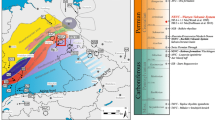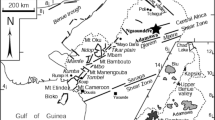Abstract
Kanaga island is located in the central Aleutian island arc. Northeastern Kanaga is a currently active late Tertiary to Recent calc-alkaline volcanic complex. Basaltic andesite to andesite lavas record three episodes (series) of volcanic activity. Series I and Series II lavas are all andesite while Series III lavas are basaltic andesite to andesite. Four Series II andesites contain abundant quenched magmatic inclusions ranging in composition from high-MgO low-alumina basalt to low-MgO highalumina basalt. The spectrum of lava compositions is due primarily to fractional crystallization of a parental low-MgO high-alumina basalt but with variable degrees of crustal contamination and magma mixing. The earliest Series I lavas represent mixing between high-alumina basalt and silicic andesite with maximum SiO2 contents of 65–67 wt %. Later Series I and all Series II lavas are due to mixing of andesite magmas of similar composition. The maximum SiO2 content of the pre-mixed andesites magmas is estimated at 60–63 wt %. The youngest lavas (Series III) are all non-mixed and have maximum estimated SiO2 contents of 59 wt %. The earliest Series I lavas contain a significant crustal component while all later lavas do not. It is concluded that the maximum SiO2 contents of silicic magmas, the contribution of crustal material to silicic magma generation, and the role of magma mixing all decrease with time. Furthermore, silicic magmas generated by fractional crystallization at this volcanic center have a maximum SiO2 content of 63 wt %. All of these features have also been documented at the central Aleutian Cold Bay Volcanic Center (Brophy 1987). Based on data from these two centers a model of Aleutian calc-alkaline magma chamber development is proposed. The main features are: (1) a single low pressure magma chamber is continuously supplied by primitive low-alumina basalt; (2) non-primary high-alumina basalt is formed along the chamber margins by selective gravitational settling of olivine and clinopyroxene and retention of plagioclase; (3) sidewall crystallization accompanied by crustal melting produces buoyant silicic (>63 wt % SiO2) liquids that pond at the top of the chamber, and; (4) continued sidewall crystallization, now isolated from the chamber wall, produces silicic liquids with ≤63 wt % SiO2 that increase the thickness and lowers the overall SiO2 content of the upper silicic zone. It is suggested that the maximum SiO2 content of 63% imposed on fractionation-generated magmas is due to a rheological barrier that prohibits the extraction of more silicic liquids from a crystal-liquid mush along the chamber wall.
Similar content being viewed by others
References
Albee AL, Ray R (1970) Correction factors for electron probe micro-analysis of silicates, oxides, carbonates, phosphates and sulphates. Anal Chem 42: 1408–1414
Arculus RJ, Delong Se, Kay RW, Sun SS (1977) The alkalic rock suite of Bogoslof Island, eastern Aleutian arc, Alaska. J Geol 85:177–186
Bacon CR, Druitt TH (1988) Compositional evolution of the zoned calc-alkaline magma chamber of Mount Mazama, Crater Lake, Oregon. Contrib Mineral Petrol 98:224–256
Baker DR, Eggler DH (1983) Fractionation path of Atka (Aleutians) high-alumina basalts: constraints from phase relations. J Volcanol Geotherm Res 18:387–404
Blake S, Campbell IH (1986) On the dynamics of magma-mixing during flow in volcanic conduits. Contrib Mineral Petrol 94:72–81
Blake S, Ivey GN (1986) Magma-mixing and the dynamics of with-drawal from stratified reservoirs. J Volcanol Geotherm Res 27:153–178
Brophy JG (1986) The Cold Bay volcanic center, Aleutian volcanic arc I: Implications for the origin of Hi-Alumina basalt. Contrib Mineral Petrol 93:368–380
Brophy JG (1987) The Cold Bay volcanic center, Aleutian volcanic arc II. Implications for fractionation and mixing mechanisms in calc-alkaline andesite genesis. Contrib Mineral Petrol 97:378–388
Brophy JG (1989a) Can high-alumina arc basalt be derived from low-alumina arc basalt? Evidence from Kanaga Island, Aleutians. Geology 17:333–336
Brophy JG (1989b) Basalt convection and plagioclase retention: a model for the origin of high-alumina arc basalt. J Geol 97:319–329
Brophy JG, Marsh BD (1986) On the origin of high-alumina arc basalt and the mechanics of melt extraction. J Petrol 27:763–789
Byers FM (1959) Geology of Umnak and Bogoslof Islands, Aleutian Islands, Alaska. US Geol Surv Bull 1028-L:267–369
Coats RR (1952) Magmatic differentiation in Tertiary and Quaternary volcanic rocks from Adak and Kanaga Islands, Aleutian Islands, Alaska. Geol Soc Am Bull 63:486–514
Coats RR (1956) Geology of northern Kanaga Island, Alaska. US Geol Surv Bull 1228-D:69–80
Conrad WK, Kay RW (1984) Ultramafic and mafic inclusions from Adak Island: Crystallization history, and implications of primary magmas and crustal evolution in the Aleutian arc. J Petrol 25:88–125
Crawford AJ, Falloon TJ, Eggins S (1987) The origin of island arc high-alumina basalts. Contrib Mineral Petrol 97:417–430
De Bari S, Kay SM, Kay RW (1987) Ultramafic xenoliths from Adagdak Volcano, Adak, Aleutian Islands, Alaska: deformed igneous cumulates from the Moho of an island arc. J Geol 95:329–341
Delong SE, Hodges FM, Arculus RJ (1975) Ultramafic and mafic inclusions, Kanaga Island, Alaska, and the occurrence of alkaline rocks in island arcs. J Geol 83:721–736
Drewes H, Fraser GD, Snyder GL, Barnett HF (1961) Geology of Unalaska Island and adjacent insular shelf, Aleutian Islands, Alaska. US Geol Surv Bull 1028-S:583–676
Eichelberger JC (1975) Origin of andesite and dacite: evidence of mixing at Glass Mountain in California and the other circum-Pacific volcanoes. Geol Soc Am Bull 86:1381–1391
Ewart A (1982) The mineralogy and petrology of Tertiary-Recent orogenic volcanic rocks: with special reference to the andesitic-basaltic compositional range. In: Thorpe RS (ed) Andesites: orogenic andesites and related rocks. Wiley, New York, pp 25–95
Fraser GD, Barnett HF (1959) Geology of the Delarof and western-most Andreanof Islands, Aleutian Islands, Alaska. US Geol Surv Bull 1028-I:211–248
Gill JB (1980) Orogenic andesites and plate tectonics. Springer, Berlin, Heidelberg, New York, 390 pp
Grove TL, Baker MB (1984) Phase equilibrium controls on the tholeiitic versus calc-alkaline differentiation trends. J Geophys Res 89:3253–3274
Grove TL, Gerlach DG, Sando TW (1982) Origin of calc-alkaline series lavas at Medicine Lake Volcano by fractionation, assimilation and mixing. Contrib Mineral Petrol 80:160–182
Grove TL, Donnelly-Nolan JM (1986) The evolution of young silicic lavas at Medicine Lake Volcano, California: implications for the origin of compositional gaps in calc-alkaline series lavas. Contrib Mineral Petrol 92:281–302
Grove TL, Kinzler RJ, Baker MB, Donnelly-Nolan JM, Lesher CM (1988) Assimilation of granite by basaltic magma at Burnt Lava flow, Medicine Lake Volcano, northern California: decoupling of heat and mass transfer. Contrib Mineral Petrol 99:320–343
Gust DA, Perfit MR (1987) Phase relations of a high-Mg basalt from the Aleutian island arc: implications for primary island arc basalts and high-Al basalts. Contrib Mineral Petrol 97:7–18
Huppert HE, Sparks RSJ, Turner JS (1982) Effects of volatiles on mixing in calc-alkaline magma systems. Nature 297:554–557
Kay RW (1977) Geochemical constraints on the origin of Aleutian magmas. In: Talwani M, Pitmann III WC (eds) Island arcs, deep sea trenches and back-arcbasins. Maurice Ewing Series I, Am Geophys Union, Washington, DC, pp 229–242
Kay SM, Kay RW (1985a) Role of crustal cumulates and the oceanic crust in the formation of the lower crust of the Aleutian arc. Geology 13:461–464
Kay SM, Kay RW (1985b) Aleutian tholeiitic and calc-alkaline magma series I: the mafic phenocrysts. Contrib Mineral Petrol 90:276–290
Kay SM, Kay RW, Citron GP (1982) Tectonic controls on tholeiitic and calc-alkaline magmatism in the Aleutian arc. J Geophys Res 87:4051–4072
Koyaguchi T (1985) Magma mixing in a conduit. J Volcanol Geotherm Res 25:365–369
Marsh BD (1976) Some Aleutian andesites: their nature and source. J Geol 84:27–45
Marsh BD (1981) On the crystallinity, probability of occurrence, and rheology of lava and magma. Contrib Mineral Petrol 78:85–98
Marsh BD (1987) Magmatic processes. Rev Geophys 25:1043–1053
Marsh BD, Leitz RE (1979) Geology of Amak Island, Aleutian Islands, Alaska. J Geol 87:1196–1206
McBirney AR (1980) Mixing and unmixing of magmas. J Volcanol Geotherm Res 7:357–371
McBirney AR, Baker BH, Nilson RH (1985) Lipid fractionation. Part I: basic principles and experimental simulations. J Volcanol Geotherm Res 24:1–24
McBirney AR, Taylor HP, Armstrong RL (1987) Paricutin re-examined: a classic example of crustal assimilation in calc-alkaline magma. Contrib Mineral Petrol 95:4–20
Miyashiro A (1974) Volcanic rock series in island arcs and active continental margins. Am J Sci 274:321–355
Myers DJ (1988) Possible petrogenetic relations between low- and high-MgO Aleutian basalts. Geol Soc Am Bull 100:1040–1053
Myers JD, Marsh BD, Sinha AK (1985) Strontium isotopic and selected trace element variations between two Aleutian volcanic centers (Adak and Atka): implications for the development of arc volcanic plumbing systems. Contrib Mineral Petrol 91:221–234
Perfit MR, Brueckner H, Lawrence J, Kay RW (1980) Trace element and isotopic variations in a zoned pluton and associated rocks, Unalaska Island, Alaska: a model for fractionation in the Aleutian calc-alkaline suite. Contrib Mineral Petrol 73:69–87
Ross CS, Foster MD, Myers AT (1954) Origin of dunite and olivine rich inclusions in basaltic rocks. Am Mineral 30:693–737
Sack RO, Carmichael ISE, Rivers M, Ghiorso MS (1980) Ferricferrous equilibria in natural silicate liquids at 1 bar. Contrib Mineral Petrol 79:169–186
Sakuyama M (1981) Petrologic study of the Myoko and Kurohime volcanoes, Japan: crystallization sequence and evidence for magma mixing. J Petrol 22:553–583
Scholl DW, Vallier TL, Stevenson AJ (1983) Arc, forearc, and trench sedimentation and tectonics: Amlia Corridor of the Aleutian Ridge. In: Watkins JS, Drake CL (eds) Studies in continental margin geology. Am Assoc Petroleum Geologists Mem 34:413–439
Smith DR, Leeman WP (1987) Petrogenesis of Mount St Helens dacitic magmas. J Geophys Res 92:10313–10334
Snyder GL (1959) Geology of Little Sitkin Island, Alaska. US Geol Surv Bull 1028-H:169–210
Sparks RSJ, Sigurdsson H, Wilson L (1977) Magma mixing: a mechanism for triggering acid explosive eruptions. Nature 267:315–318
Sparks RSJ, Huppert HE, Turner JS (1984) The fluid dynamics of evolving magma chambers. Phil Trans R Soc Lond A310:511–534
Stormer JC Jr (1983) The effects of recalculation on estimates of temperature and oxygen fugacity from analyses of multi-component Fe−Ti oxides. Am Mineral 68:586–594
Turner JS, Huppert HE, Sparks RSJ (1983) An experimental investigation of volatile exsolution in evolving magma chambers. J Volcanol Geotherm Res 16:263–277
Turner JS, Campbell IH (1986) Convection and mixing in magma chambers. Earth Sci Rev 23:255–352
Walker D, Shibata T, Delong SE (1979) Abyssal tholeiites from the Oceanographer Fracture Zone: II Phase equilibria and mixing. Contrib Mineral Petrol 70:111–125
Webster JR, Brophy JG (1988) Evidence for temporal evolution in the relative roles of fractionation and magma mixing at the Broken Top Volcano, central Oregon. Geol Soc Am Abstr Prog 20:A196
Wheller GE, Varne R (1987) Genesis of dacitic magmatism at Batur Volcano, Ball, Indonesia: Implications for the origins of stratovolcano calderas. J Volcanol Geotherm Res 28:363–378
Author information
Authors and Affiliations
Rights and permissions
About this article
Cite this article
Brophy, J.G. Andesites from northeastern Kanaga Island, Aleutians. Contr. Mineral. and Petrol. 104, 568–581 (1990). https://doi.org/10.1007/BF00306665
Received:
Accepted:
Issue Date:
DOI: https://doi.org/10.1007/BF00306665




